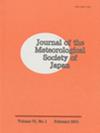基于两年在轨数据的Himawari-8/AHI辐射定标验证
IF 1.6
4区 地球科学
Q3 METEOROLOGY & ATMOSPHERIC SCIENCES
引用次数: 23
摘要
日本气象厅新的地球静止轨道气象卫星Himawari-8于2015年7月7日投入运行。Himawari-8采用了新的16波段高级Himawari成像仪(AHI),其空间分辨率和观测频率比其前身MTSAT系列卫星有所提高。这些改进将为实时广播服务和短程天气预报系统带来前所未有的性能水平。鉴于导航和辐射定标在充分利用成像仪潜力方面的本质,本研究报告了AHI的定标现状。图像导航精确到1公里以内,带间配准也得到了验证。红外波段校准精确到0.2 K以内,没有显著的日变化,目前正在使用全球天基相互校准系统框架下开发的方法进行验证。目前正在对可见光和近红外波段的验证方法进行测试。对两种这样的方法进行了比较,结果基本一致。本文章由计算机程序翻译,如有差异,请以英文原文为准。
Validation of Himawari-8/AHI Radiometric Calibration Based on Two Years of In-Orbit Data
The new geostationary (GEO) meteorological satellite of the Japan Meteorological Agency (JMA), Himawari-8, entered operation on 7 July 2015. Himawari-8 features the new 16-band Advanced Himawari Imager (AHI), whose spatial resolution and observation frequency are improved over those of its predecessor MTSAT-series satellites. These improvements will bring about unprecedented levels of performance in nowcasting services and short-range weather forecasting systems. In view of the essential nature of navigation and radiometric calibration in fully leveraging the imager’s potential, this study reports on the current status of calibration for the AHI. Image navigation is accurate to within 1 km, and band-to-band coregistration has also been validated. Infrared (IR) band calibration is accurate to within 0.2 K with no significant diurnal variation and is being validated using an approach developed under the Global Space-based Inter-Calibration System (GSICS) framework. Validation approaches are currently being tested for the visible and near-IR (NIR) bands. Two such approaches were compared and found to produce largely consistent results.
求助全文
通过发布文献求助,成功后即可免费获取论文全文。
去求助
来源期刊
CiteScore
6.70
自引率
16.10%
发文量
56
审稿时长
3 months
期刊介绍:
JMSJ publishes Articles and Notes and Correspondence that report novel scientific discoveries or technical developments that advance understanding in meteorology and related sciences. The journal’s broad scope includes meteorological observations, modeling, data assimilation, analyses, global and regional climate research, satellite remote sensing, chemistry and transport, and dynamic meteorology including geophysical fluid dynamics. In particular, JMSJ welcomes papers related to Asian monsoons, climate and mesoscale models, and numerical weather forecasts. Insightful and well-structured original Review Articles that describe the advances and challenges in meteorology and related sciences are also welcome.

 求助内容:
求助内容: 应助结果提醒方式:
应助结果提醒方式:


